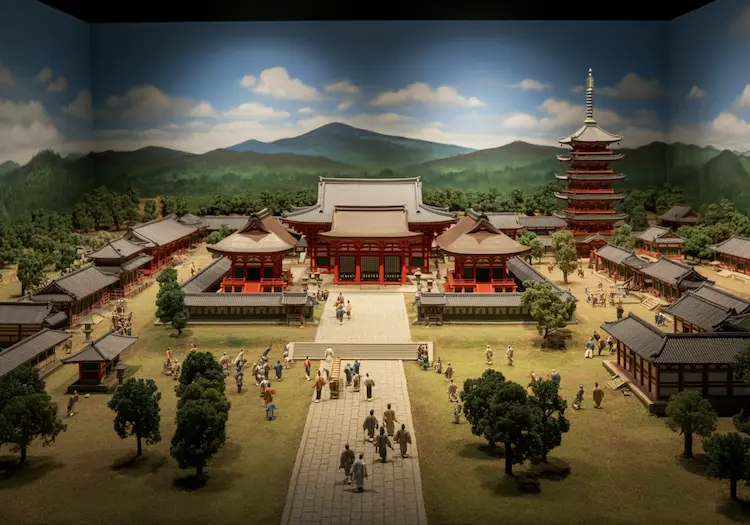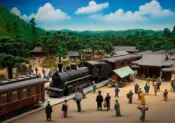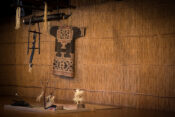Nara Period – Heijō-kyō as the Center of Japan
In 710 AD, Japan’s capital was established in Nara, and Heijō-kyō emerged as the heart of Japan’s political and cultural life. The Nara period represents a formative stage in Japan’s history, where cultural, political, and religious foundations were laid that would shape the nation’s future. This article takes you through the wonders of Heijō-kyō, exploring its majestic temples, grand palaces, literary achievements, and the influence of international culture. Let us journey back to this remarkable time when Nara stood as the epicenter of progress and creativity.
- The Construction of Heijō-kyō and Nara’s Growth as a National Center
- Tōdai-ji and the Great Buddha
- Shōsōin and Its Historical Value
- The Compilation of Japan’s First Histories and Literature
- Influence of Tang Culture and Internationality
- Modern Connections to the Nara Period
- Conclusion: Experiencing the Glory of Nara
The Construction of Heijō-kyō and Nara’s Growth as a National Center
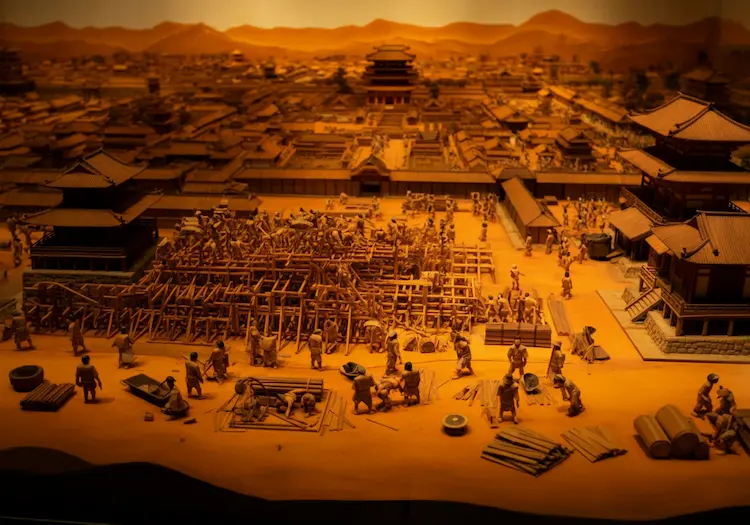
- Building Heijō-kyō: In 710, the capital of Japan moved to Heijō-kyō, located in what is now modern-day Nara. The layout of this new capital was inspired by Chang’an, the capital of China’s Tang Dynasty. The city was meticulously planned, with a grid-like pattern of streets and an impressive palace at its core. The establishment of Heijō-kyō symbolized a new era for Japan, where a central government aimed to consolidate power and promote cultural and political stability.
- Nara as the Center of Japan: During the Nara period, the city became the center of political, cultural, and religious activities. The imperial court established numerous offices and structures in Heijō-kyō to ensure effective governance. This period also saw the creation of Japan’s first national census and land registration system, highlighting the growing centralization of power. Nara’s position as the center of Japan made it a hub for cultural and international exchanges, which contributed significantly to the development of Japanese society.
Tōdai-ji and the Great Buddha
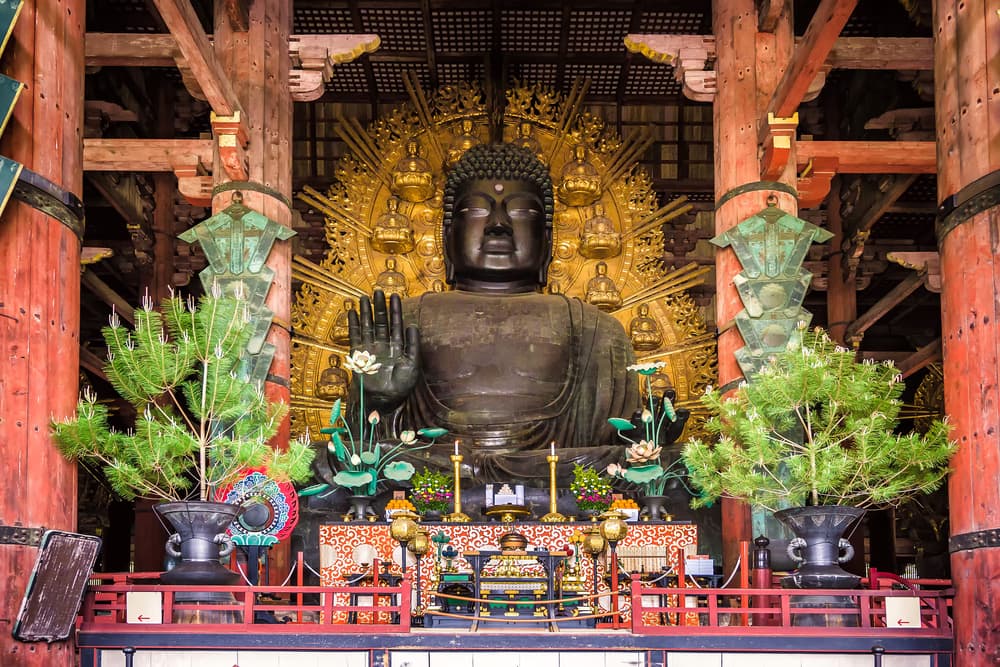
- The Construction of Tōdai-ji: One of the most iconic monuments of the Nara period is Tōdai-ji, a massive temple founded in 752 under the patronage of Emperor Shōmū. The temple was built as a spiritual project aimed at bringing peace to the nation. It symbolized the unification of Japan under Buddhism, which was considered essential for the country’s stability and prosperity. The grandeur of Tōdai-ji was unparalleled, and its construction required resources from every corner of the empire.
- The Great Buddha of Nara: At the heart of Tōdai-ji stands the Great Buddha (Daibutsu), an enormous bronze statue depicting Vairocana Buddha. This colossal statue, measuring over 15 meters in height, represented the hope of a stable and prosperous nation, and its construction involved countless artisans and a significant portion of the nation’s wealth. The Daibutsu project brought together people from all walks of life, symbolizing the unity of the Japanese people in pursuit of collective peace.
Shōsōin and Its Historical Value
- The Role of Shōsōin: Shōsōin served as the imperial repository, safeguarding important artifacts, documents, and treasures collected from across Japan and beyond. Built in a unique architectural style, the structure of Shōsōin was designed to preserve its precious contents for generations. The treasures housed here include valuable objects that reflect the culture, technology, and lifestyle of the Nara period.
- A Testament to Cultural Exchange: The items stored in Shōsōin tell a story of the international connections that Japan enjoyed during the Nara period. From Persian glassware to Chinese textiles, these artifacts demonstrate the cultural exchange facilitated by the Silk Road, which reached as far as Nara. Shōsōin remains one of the most significant historical repositories in Japan, and its collection offers insights into the cultural richness and openness of Nara during this era.
The Compilation of Japan’s First Histories and Literature
- The Creation of Nihon Shoki: One of the most critical cultural achievements of the Nara period was the compilation of the “Nihon Shoki” (Chronicles of Japan) in 720. This historical text was intended to provide legitimacy to the ruling Yamato dynasty by documenting the origins and exploits of Japan’s rulers. Nihon Shoki serves as one of the foundational texts for understanding early Japanese history, and it helped establish a sense of national identity at a crucial time.
- The Man’yōshū Anthology: Another major accomplishment of the Nara period was the creation of the “Man’yōshū,” Japan’s oldest surviving collection of poetry. The Man’yōshū comprises over 4,500 poems written by people from all walks of life—from emperors to commoners. This anthology reflects the values, emotions, and experiences of the Japanese people and remains a cherished part of Japan’s literary heritage, providing a unique glimpse into life during the Nara period.
Influence of Tang Culture and Internationality
- The Influence of Tang China: The Nara period was heavily influenced by the culture of Tang China. From the architectural style of Heijō-kyō to the adoption of Confucian principles and Buddhist practices, Tang China’s impact was profound. The Japanese government sent emissaries to China, bringing back not only political ideas but also cultural and technological knowledge that greatly enriched Japanese society.
- Nara as an International Hub: Nara was not only influenced by China but also engaged in exchanges with the Korean peninsula and Southeast Asia. Heijō-kyō became a melting pot of ideas, culture, and people. This internationalism helped shape a rich and diverse cultural landscape, making Nara a dynamic center of exchange that welcomed foreign innovations while adapting them to the Japanese context.
Modern Connections to the Nara Period
- Exploring Heijō Palace and Tōdai-ji Today: Today, many remnants of the Nara period can still be explored in modern Nara. The ruins of Heijō Palace offer a glimpse into the grandeur of Japan’s ancient capital, while Tōdai-ji and its Great Buddha continue to be symbols of peace and spirituality, attracting visitors from around the world. Visiting these sites offers a powerful connection to Japan’s historical roots.
- Cultural Exhibitions and Events: Modern Japan continues to celebrate the Nara period through events like the Shōsōin Exhibition, which showcases the treasures held within the ancient storehouse. These cultural exhibitions allow people to experience firsthand the beauty and complexity of Nara’s heritage and to appreciate the cultural exchanges that made the period so distinctive.
Conclusion: Experiencing the Glory of Nara
The Nara period represents a golden age in Japan’s history, where cultural, religious, and political advancements laid the foundation for future growth. From the establishment of Heijō-kyō as the center of power to the blossoming of Buddhism and the compilation of foundational historical texts, this era shaped the Japan we know today. By exploring Nara’s historical sites, we can connect with the legacy of a time when Japan opened itself to the world and embraced new ideas, shaping a rich cultural identity that continues to inspire us. Visit Nara and experience the grandeur of a city that once stood at the heart of Japan’s transformation.
